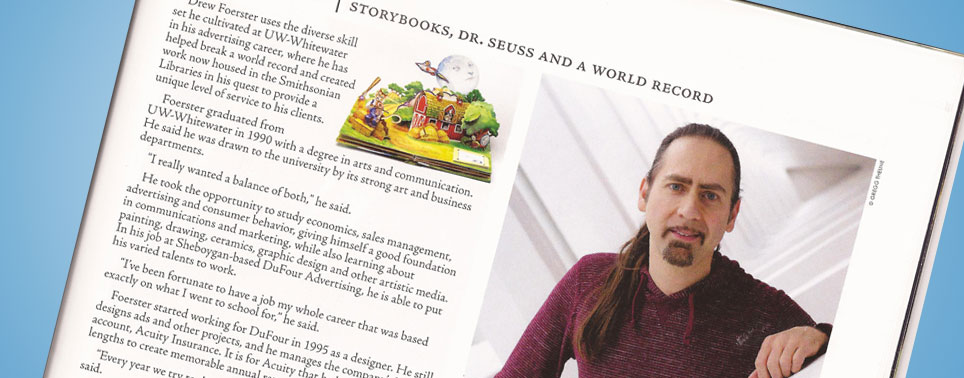
Story by Matthew van Buren for UW-Whitewater
Drew Foerster uses the diverse skill set he cultivated at UW-Whitewater in his advertising career, where he had helped break a world record and created work now housed in the Smithsonian Libraries in his quest to provide a unique level of service to his clients.
Foerster graduated from UW-Whitewater in 1990 with a degree in arts and communication. He said he was drawn to the university by its strong art and business departments.
“I really wanted a balance of both,” he said.
He took the opportunity to study economics, sales management, advertising and consumer behavior, giving himself a good foundation in communications and marketing, while also learning about painting, drawing, ceramics, graphic design and other artistic media. In his job at Sheboygan-based DuFour Advertising, he is able to put his varied talents to work.
“I’ve been fortunate to have a job my whole career that was based exactly on what I went to school for,” he said.
Foerster started working for DuFour in 1995 as a designer. He still design ads and other projects, and he manages the company’s biggest account, ACUITY Insurance. It is for ACUITY that he had gone to great lengths to create memorable annual reports.
“Every ear we try to do something really out-of-the-ordinary,” he said.
One year the ACUITY report parodied Dr. Seuss, featuring illustration and rhyme. Another was based on the Guinness Book of World Records, and Foerster even arranged for ACUITY employees to break a world record — the most people dressed like “Where’s Waldo.”
“ACUITY’s corporate culture is unlike any other I’ve seen,” he said. “Everyone is very creative.”
For ACUITY’s 2010 report, Foerster designed a pop-up book, above, to illustrate ACUITY’s “storybook year.” The 16-month-long project even took him halfway around the world for three weeks to supervise production in China.
The 2010 report is now permanently housed in the Smithsonian, where is was made part of the Cooper-Hewitt collection’s “rare books” section.
